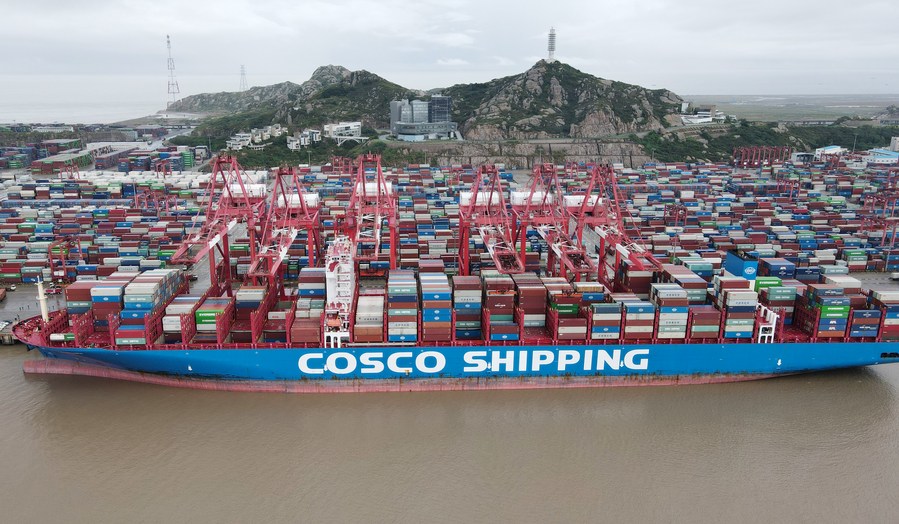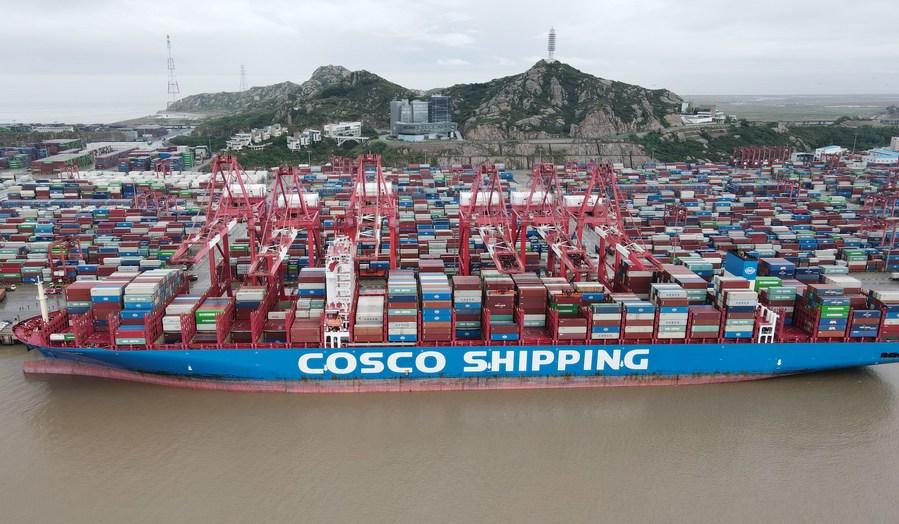
Aerial photo taken on Oct. 13, 2021 shows the container ship Libra of China's COSCO Shipping at Shanghai Yangshan Port, east China. (Xinhua/Fang Zhe)
BEIJING, Jan. 12 (Xinhua) – China has recently rolled out multiple policies to help import and export enterprises overcome difficulties, with relevant departments taking the stabilization of foreign trade as their priority in 2022 and 22 departments and units have jointly released a package of measures for a stable start of foreign trade in 2022, Economic Information Daily reported Friday.
Based on the full assessment of the difficulties and challenges facing this year, China will arrange and execute policies for foreign trade in the earliest time to secure greater initiative in effectively stabilizing the expectation and confidence of foreign trade enterprises and upgrading the quality of foreign trade in the whole year, according to the report.
-Full and well-prepared assessment for stabilizing foreign trade
Statistics show that China's total foreign trade from January to November in 2021 reached 5.48 trillion U.S. dollars, with a year-on-year increase of 31.3 percent. In the first three quarters, the GDP contribution of net export of goods and services was 19.5 percent, creating a growth of 2 percentage in GDP and making a significant contribution to the stability of economic growth.
While fully recognizing the achievements, China should also be aware of the prominent pressures of 'shrinking demand, supply shock and weak expectations' in foreign trade, as pointed out at the Central Conference on Economic Work, said Ren Hongbin, Chinese Vice Minister of Commerce.
Impacted by the COVID-19 pandemic, global economic recovery is still on shaky ground and external demand remains sluggish. The burden on enterprises increases due to shortage of chips, containers and labor forces as well as the rise in freight cost, raw material cost, energy cost and the exchange rate of the RMB, he added.
According to Wang Wentao, Minister of Commerce, due to the recovery slowdown of global demand and the decreasing impact of the transitory factors such as order back-flow and export of products in "stay-home economy", foreign trade enterprises are still plagued with the difficulties such as rising price of raw materials, insufficient transport capacity, skyrocketing freight, and higher labor cost. Confronted with these risks and challenges which are coupled with the high base figure of the foreign trade in 2021, there is still huge pressure in stabilizing foreign trade in 2022.
Wang Wentao also emphasized that, in 2022, China will maintain the continuity and stability of relevant policies, promptly rolling out new policies and measures in line with requirements of cross-cyclical and counter-cyclical adjustment, maximizing the role of policies at the earliest time.
-Early arrangement, multiple measures to ensure stable foreign trade in the year beginning
The recent executive meeting of the State Council proposed that China should further pursue wider opening, launch measures to address difficulties and challenges, strengthen cross-cyclical adjustment, subsidize and help enterprises, especially small, medium and micro-sized enterprises, and ensure orders, stabilize expectations, and boost steady growth of foreign trade.
The implementation of relevant measures is accelerated. Focusing on existing difficulties and challenges of foreign trade in 2022, the Ministry of Commerce (MOFCOM) will respond to enterprises' appeals and put forward a package of measures based on good experience and practices at the local levels, together with 22 departments and units such as the National Development and Reform Commission (NDRC), the Ministry of Finance and the People's Bank of China, said Ren Hongbin.
The measures include 15 policies in four aspects. Namely, to strengthen the support of fiscal taxation and financial policies, to further boost the development of new forms of foreign trade such as cross-border e-commerce, to reduce the pressure of the industries engaged in supply chain of foreign trade such as international logistics, and to support the major industries and major enterprises.
In addition, to handle the risks of exchange rate fluctuations, and address the problems of "no revenue increase in export, and no higher profits in higher revenue" reported by enterprises, the MOFCOM will coordinate with relevant departments to advance the work from three aspects: guide enterprises to "make plans as the conditions permit" and enhance the capacity of addressing exchange rate risks; encourage banks to "apply targeted policies tailored to specific enterprises" and provide targeted products and services to hedge risks; encourage local governments to "adopt measures in light of local conditions" and support local commerce authorities in strengthening collaboration with local departments and financial institutions, implementing measures in detail.
-A long-term perspective for foreign trade upgrading
Notably, while addressing current difficulties and ensuring a stable start, China should adopt long-term policies to advance the overall transformation and upgrading of China's foreign trade and foster competitiveness in the international market.
Han Wenxiu, Deputy Director of the Central Committee for Financial and Economic Affairs, said in an article that, from 2021, export has made a significant contribution to stabilizing macro economy. We should expand high-level opening-up, translate advantages of short-term orders into medium- and long-term advantage of international competition in order to stabilize the fundamentals of foreign trade and foreign investment.
According to Ning Jizhe, Deputy Director of the NDRC and Commissioner and Party Secretary of the National Bureau of Statistics of China (NBS), China should promote innovative development of digital trade, and vigorously develop new modes and new business forms such as cross-border e-commerce and market procurement trade, and constantly improve overseas warehouse network covering all corners of the globe. The exports of technologically-advanced products that are of high quality and value-added should be supported and the promotion of Chinese brands in the world should be enhanced.
As an accelerator fueling economic transformation and upgrading, foreign trade needs to follow the new development rends while fully tap new potentials at the same time, and foster new competitive edges of China's foreign trade in the new development paradigm, said Zhu Caihua, a professor at the Institute of International Economy of University of International Business and Economics.
China should leverage the opportunity of digital trade, tap the potential of trade digitization, and accelerate the development of new modes and new business forms such as digital marketing, cross-border e-commerce, and market procurement trade. In addition, China should fully leverage the benefits from the participation in establishing high-standard free trade agreements, especially the Regional Comprehensive Economic Partnership Agreement (RCEP), and work harder to foster more stable regional industrial, supply and value chains, Zhu suggested.
(Edited by Gao Jingyan with Xinhua Silk Road, gaojingyan@xinhua.org)




 A single purchase
A single purchase









